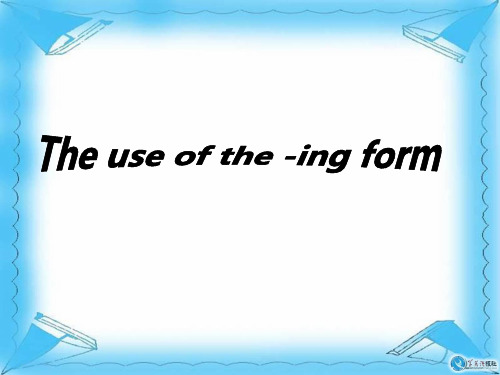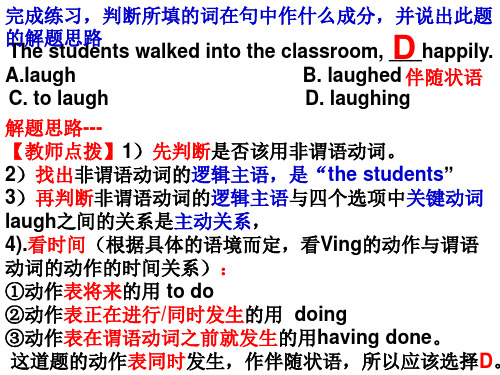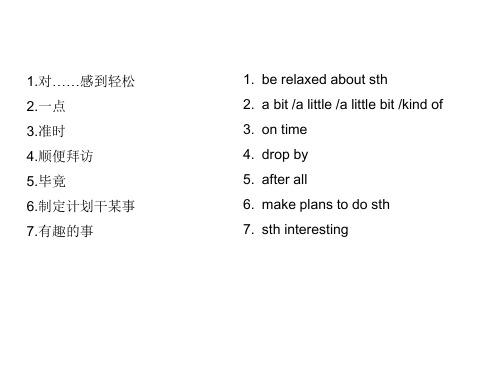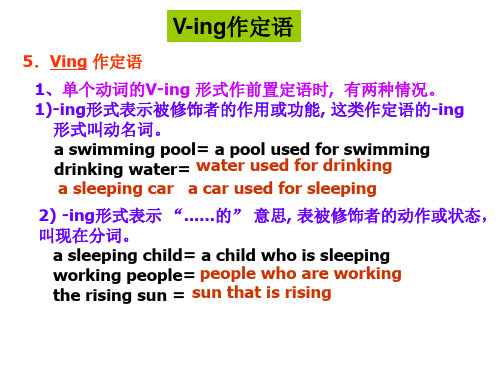ving作状语
ving做定语和状语的用法

Answer key for Exercise 2.
approached, Jordan, cheek, curiously, dashed, misunderstood, contrary
Answer key for Exercise 3.
crossroads, adult, major, dormitory, greeted, representing, association, spoken, Colombia, curious, flight
2. The glass doors have taken the place of
the wooden ones at the entrance, ___ in
the natural light during the day. (天
津2007)
A. to let B. letting
C. let
人教课标版 高一 必修4
Unit 4
Grammar
Discovering useful words and expressions: Answer key for Exercise 1.
defence, likely, Italy, canteen, represent, dash, approach, association, cheek, flight
2. The person who is translating the songs can speak seven languages. The person _tr_a_n_s_l_a_ti_n_g_t_h_e _so_n__g_s can speak seven languages.
3. The boy standing there is reading a book about body language. The boy _w_h_o_ _is_ _s_t_a_n_d_in_g_ there is reading a book about body language.
ving做定语和状语

定语
非谓语动词 doing 表示:主动的或正在进行的动作 过去分词(done) 表示:被动的或完成的动作 to do 表示:目的或将来的动作
动词--ing形式作定语和状语
I.v-ing 形式作定语,相当于形容词 前置定语: ving(一个单词)+n 后置定语: n+ ving短语(大于一个单词) 1.表示正在进行 a listening child= a child who is listening 2.表示功能用途 a walking stick= a stick for walking. 3.表示性质 an interesting book
5) 表条件
If you use your head, you will find a way.
=Using your head, you will find a way. 一直往前走, 你就会看到一座白色地房子。 ______________, Walking ahead you will see a white house.
单句改错
1. Having not seen the film, I can’t tell you what I think of it. Not having 2. The men worked for extra hours got an extra pay. working 3. Seen from the top of the hill, we find the city more beautiful. Seeing 4. Generally speak, facial expressions are helpful communications, too. speaking
Ving作状语

表示动作的结果
Ving作状语可以表示动作的自然结果 Ving作状语可以表示动作的预期结果 Ving作状语可以表示动作的意外结果 Ving作状语可以表示动作的伴随结果
与-ing分词短语的区别
结构不同:-ing分词短语是独立的结构,而Ving作状语是作为状语存在的。
意思不同:-ing分词短语通常表示正在进行的动作或状态,而Ving作状语可以表示 时间、条件、让步等关系。
Ving作状语可以表示伴随的动作,如“He walked along the river,singing l o u d l y. ”
Ving作状语可以表示结果,如“I tried to open the door,only to find it locked.”
表示动作的伴随情况
Ving作状语可以表示主语执行的动作的同时伴随其他动作的发生 Ving作状语可以用来描述主语在执行主要动作时伴随的状态或条件 Ving作状语可以用来强调主语执行的动作与伴随动作之间的关联性 Ving作状语可以用来补充说明主语执行的动作时伴随的其他情况
书面语与口语的区 分
正式与非正式场合 的区分
特定语境场合的区 分
不同领域和专业领 域的区分
注意与其它成分的搭配
注意与主语的搭配:Ving作状语时,应与主语保持逻辑一致,避免产生歧义。 注意与谓语的搭配:Ving作状语时,应与谓语保持时态和语态的一致,以避免语法错误。 注意与宾语的搭配:Ving作状语时,应与宾语保持逻辑一致,确保句子的意思清晰明确。 注意与其它状语的搭配:Ving作状语时,应与其他状语保持合理的顺序,以使句子更加通顺。
汇报人:XX
添加标题
添加标题
添加标题
添加标题
语义关系不同:Ving作状语与独立 主格结构在语义关系上存在差异。
ving作状语经典 ppt课件

…and left her 3 kids to look after.
2020/12/12
7
5) Four people entered the room looking
around in a curious way.
伴随状语
Four people entered the room and looked around in a curious way.
through himself.
2020/12/12
11
1. Being poor, he couldn’t afford a TV set. 2. Being ill, he didn’t go to school. 3. Being poor, the old man was happy.
Tip 4: be - being
4. Not knowing her address, we can’t get in touch with her.
succeed.
If you work hard
2020/12/12
5
Because he was poor
2). Being poor, he couldn’t afford a TV set. (原因)
As we don’t know her address
Not knowing her address, we can’t get in touch with her.
2.Will, still watching, saw the cat behave curiously. 3.He crossed the road, keeping his eyes on the spot
v-ing作状语 经典课件

3). Walking in the street, I saw a tailor’s shop. 时间
When I was walking in the street.
4). Her husband died, leaving her 3 kids to look after.
结果
…and left her 3 kids to look after.
1. Being poor, he couldn’t afford a TV set. 2. Being ill, he didn’t go to school. 3. Being poor, the old man was happy. Tip 4: be - being
4. Not knowing her address, we can’t get in touch with her. Tip 5: 否定在Ving前加not
Grammar Ving as Adverbial —动词ing做状语
Read the sentences and try to feel.
1.When I was walking in the street, I came across an old friend of mine. Walking in the street, I came across an old friend of mine.
ving作状语的四种形式一般式进行被动beingdonehavingdonehavingbeendoneving动作与谓语同时发生主语一致且为主动ving动作正在进行且与主语成被动关系ving先于谓语动作完成且造成影响主动ving先于谓语动作发生且为被动有影响相当于过去分词iii
Module 2 Fantasy Literature
ving的用法解读

例句
• • • • 1. Avoid over-eating. 2.He admitted taking the money. 3.I can’t help laughing. 4.I finished reading the book last night.
②既可接动名词又可接不定式作 宾语的动词,常见的有:begin, start,continue,intend,like, love,prefer,mean,forget, regret, remember,hate ,go on, stop 等。
我真后悔没赶上那次报告会。 I regret missing the report. 我遗憾地告诉你我不能接受你的建 议。 I regret to say I can’t take your advice.
D在try,mean之后意义各不相同, try to do (设法), try doing (试试), mean to do (打算,有意要做) mean doing (意思是,意味着)。如:
• a book explaining how to cut the death rate • Following jane’s way of studying chimps, our group are going to visit the动形式
比较下列三组句子
• 我记得我已把信寄了。 • I remember posting the letter. • 我会记着去寄信的。 • I’ll remember to post the letter.
我永远不会忘记见到过那位著名 作家。 I shall never forget seeing the famous writer. 不要忘了给你母亲写信。 Don’t forget to write to your mother.
ving作状语

状语
Will you scream(尖叫) when seeing him?
Learning aims: 1. The functions of V-ing form as adverbial. 2. The testing points of V-ing form as adverbial in the college entrance examination.
Watching every motion in my foolish lover's game, On this endless ocean finally lovers know no shame Turning and returning to some secret place inside Watching in slow motion as you turn around and say: take my breath away,take my breath away
Function of V-ing form as adverbial
1. We sat in the classroom, listening to the teacher
carefully.
伴随状语
2. If working hard, we can all achieve our dreams. 条件状语 3. The heavy rain lasted for a month in Xiamen, causing a lot of damage.
Describe the pictures according to the hints.
sit on the sofa; read a report Professor Du sat on the sofa, reading a report at home.
Ving作主宾表定状补

A. 在 like, love, hate, prefer之后, 用-ing或to do意思一样,不过-ing表泛指 to do表具体、一次性动作 B. 在 begin/start, continue之后, 用-ing或to do意思一样 C. 在动词forget, remember, regret之后, 动名词表示动作做了, 不定式表示没做
Walking ________(walk)is a good form of exercise for both young and old.
Watching _________(watch)news on TV has become a routine for me.
教育孩子需要耐心。 Teaching children needs patience.
其他补充: 其他补充: go on/carry on/stop doing停/继续正在做的 go on/carry on/stop to do 停/继续转另一事 mean/try to do 打算/努力去做 mean/try doing 意味着/尝试 be used to doing (介词)适应于 be used to do (被动)被用作.. can’t help doing 情不自禁 can’t help to do 不能帮助
— Let me tell you something about the journalists. B — Don’t you remember ________ me the story yesterday? A. told B. telling C. to tell D. to have told
Grammar
The –ing form as the Subject and Object
Ving作状语的解题技巧

_ __ __
____
_______ __ ___________________
ing作结果状语时,一般用doing的一般式,其逻辑 主语是一件事(即:前面的整个句子)
Eg: 1. ____________making him end up in He robbed the bank, prison. 2.______________ winning the final Their team worked hard, game. 配套练习: Some factories pour their waste chemicals C into the river, ______the river and the fish . A. to kill B. killed C. killing D. having killed
配套练习:做综合练习2、4题 2.C 4. D 第四步:判断Ving的动作与谓语动词的时间关系 任务:比较下列句子,注意划线部分,判断ving与 谓语动词的时间关系。 1. He stood there waiting for his mother. 2. Having waited for two hours, he went away. 方法: doing/being done ①动作表正在进行/与谓语动词同时发生的用___________ ②动作表在谓语动词之前就发生的用_____________ having done/having been done ③动作表将来的用 to do/to be done
读下列句子,找出-ing的逻辑主语 1. Opening the door, I found nobody in. 2. Being poor, they couldn’t afford to buy a house. 3. Working hard, you’ll succeed. 4. Weighing 100 kilograms, the stone was moved by him alone. 5. The other people sat in the chair and acted out the story using sign language. 6. They sat there, smiling. 7. His parents were killed in the earthquake , leaving him an orphan. 教师点拨:
动词Ving的用法

4.作状语表示伴随状况 1).The children went to the park, laughing on the way. 2).She lies on the bed, holding one of her toy animals. 3).You look at me and I look at you, both knowing. 4).She entered the room, smiling from ear to ear. 5).He said to himself, putting all the money in his pocket. 5.作状语表示原因 Feeling tried, I went to bed early. Being ill, he didn’t come to school today.
6.制定计划干某事
7.有趣的事
V-ing 是动词的一种非谓语形式,不能单独作谓语,与不定式 一样, V-ing也可以带有自己的宾语或状语,构成V-ing短语。 1.作主语 Talking is easier than doing. Going to college is my dream. Spending time with your family and your friends is very important. 2.作宾语 I practice speaking English every day. I have already finished doing my homework. He’s looking forword to seeing you. Thank you for helping me. 3.作宾补 Suddenly I saw a woman lying on the ground. I kept the fire burning all day and all night.
V-ing 作状语

2.V-ing形式与句子主语之间的主动与被动关系. 当V-ing形式与句子主语之间存在逻辑上的主谓关系 时,用主动式 。 当V-ing形式与句子主语之间存在逻辑上的动宾关系 时,用被动式 。 Not receiving any letter from him, I gave him a call. 由于没有收到他的信,我给他打了个电话。(逻辑上 的主谓关系) Having being told many times, he still couldn’t understand it. 多次被告知后,他还是不懂。 (Having being told…与句子主语之间存在逻辑上 的动宾关系,并表示动作在前。)
Having finished their work,they had a rest. (相当于时间状语从句) After they finished their work,they had a rest.
二、形式与基本句型
1.V-ing形式有下列形式变化.
主动式 一般式为 v-ing 完成式为having v-ed
3) 表方式、伴随状语可转换成并列句
He sat on the sofa, watching TV. (=He sat on the sofa, and watched TV.)
他斜靠(lean)着墙站着。 He stood leaning against the wall. (=He stood and leaned against the wall.)
时间关系当ving形式所表示的动作与主句谓语动词所表示的动作同时或几乎同时发生时用一般式
V-ing作定语
5.Ving 作定语 1、单个动词的V-ing 形式作前置定语时, 有两种情况。 1)-ing形式表示被修饰者的作用或功能, 这类作定语的-ing 形式叫动名词。 a swimming pool= a pool used for swimming drinking water= water used for drinking a sleeping car a car used for sleeping
- 1、下载文档前请自行甄别文档内容的完整性,平台不提供额外的编辑、内容补充、找答案等附加服务。
- 2、"仅部分预览"的文档,不可在线预览部分如存在完整性等问题,可反馈申请退款(可完整预览的文档不适用该条件!)。
- 3、如文档侵犯您的权益,请联系客服反馈,我们会尽快为您处理(人工客服工作时间:9:00-18:30)。
v-ing形式作状语v-ing形式作状语时,用于修饰某动词或整个句子,所表示的动作与句子主语构成逻辑上的主谓关系。
v-ing形式作状语时,可以单独使用,也可以在其前加上when,while,after,if,unless,although,though等连词,表示时间、原因、条件、让步、结果、伴随、方式等。
1. 作时间状语Hearing this news, she got frightened. 听到这个消息,她感到害怕。
Looking out of the window, I saw some children playing football.Turning around , he saw a tiger running up.2. 作结果状语The boy ran even faster,reaching the school out of breath. 那个男孩跑得更快了,到达学校时累得上气不接下气了。
The child slipped and fell, hitting his head against the door.Her husband died, leaving her four children.They fired, killing many people in the street.3. 作伴随状语He stood by the window, watching people passing by his window.He came running.She stood waiting for a bus.He sat there reading a book.The students ran out of the classroom, talking and laughing.4. 作原因状语Being a student, I must study hard. 作为一名学生,我必须努力学习。
Seeing nobody at home, he left them a note.Not knowing his telephone number, I couldn’t get in touch with him.5. 作让步状语Having lived here for four years, I am not familiar with my neighbors. 虽然我在这儿住了四年,我对邻居们都还不熟悉。
Working or reading, she always did her best. 不管是工作还是阅读,她总是竭尽全力。
Not being a rich man himself, he helped the poor generously. 尽管他自己不算富裕,他却是慷慨的帮助穷人。
6. 作条件状语Heating water, we can change it into vapour. 把水加热,我们可以将其变为水蒸汽。
Working in his small room, he made three pairs of shoes every day. 在他的小房间里工作,每天做三双鞋。
Using your head, you’ll find a good way.Working hard, you’ll surely succeed.7. 作目的状语He stayed up late into the night, attempting to pass the entrance exam. 他晚上睡得很晚,想通过考试。
注意:一、V-ing 的时态和语态。
下表以动词do为例说明现在分词的时态和语态的不同变化形式及其否定式的构成:1.现在分词的一般式表示该动作在与谓语动作同时发生或在谓语动作之后发生,完成式则表示该动作发生在谓语动作之前,在句中只能作状语表示时间和原因。
如:Standing on top of the hill, you can see as far as the seaside. (分词动作与谓语动作同时发生)The fish can eat a person in two minutes, leaving only bones. (分词动作在谓语动作之后发生)Having finished his homework, the boy went out to play football. (分词动作在谓语动作之前发生) Having turned off the TV set, he bagan to do his homework.2. 现在分词的主动式表示动作是由句子主语发出,而被动式表明主语承受该动作。
如:Being noticed by so many people, she felt nervous, not knowing what to say.Being helped by the teacher, she will learn English well.Having been shown the lab, we were taken to see the library.Having been translated into many languages, the book was widely read all over the world.3. 现在分词的否定式是在一般式和完成式的前面加not (never)。
注意完成式的否定式应将not(never)加在have前。
如:Not having heard from her son for a long time, the mother worried a great deal.Not having been washed in the correct way, the coat has faded.二、现在分词可以与when, while, if, though等连词使用。
如:When doing your homework, you mustn't listen to the music.Though having been warned many times, she got to school late again.While reading the book, she nodded from time to time.三、v-ing形式作状语时,它的逻辑主语必须与主句的主语是一致的。
Rushing into the dining-room, supper was waiting for me.(X)Rushing into the dining-room, I found supper was waiting for me.While visiting a strange city, a guide-book is very helpful.(X)While visiting a strange city, you may find a guide-book very helpful.四、当现在分词的逻辑主语不是句中主语时,可以带有自己的主语--名词或代词主格。
这样的结构属于独立主格结构,有时前面还可加介词with构成复合结构。
Spring coming on, the trees turned green.Her mother being ill, she had to look after her at home.Time permitting, we’ll visit the Great Wall.He guiding the blind man, they walked slowly across the street.Weather permitting, we will go out for a picnic next Sunday.With so many people looking at her, the girl felt nervous.五. 固定结构:v-ing形式可以作独立成分,表示说话人的态度或看问题的角度。
如:Judging from his appearance, he must be a very healthy boy.Generally speaking, boys are more active than girls in sports.Judging from his appearance, he must be very rich.Generally speaking, his answer is right.Considering everything, they did a good job.六、V-ing形式作状语时,可以用相应的状语从句替代,从句谓语必须用主动语态。
Seeing the picture, I couldn’t help thinking of the days in America.(=When I saw the picture, I…)While reading the book, she nodded from time to time. (= While she was reading the book, she noddedfrom time to time.)Being a student, I must study hard. (= As I am a student, I must study hard.)Not knowing how to do it, he asked the teacher for help. (= As he didn’t know how to do it, he aske teacher for help.)由于不知道如何干,他请老师帮助。
Meeting anywhere else, we wouldn’t have recognized each other. (=If we had met anywhere else, we如果是在别处见面,我们彼此会认不出来的。
wouldn’t have recognized each other.)边学边练:1. Don’t sit there _______ nothing at all. Come and help me with this table.A. doB. to doC. doingD. and doing2. The snow storm left, _______ a lot of damage to southern China.A. causedB. to have causedC. to causeD. having caused3. He glanced over at her, _______ that though she was tiny, she seemed very well put together.A. notingB. notedC. to noteD. having noted4. _______ in a white uniform,he looks more like a cook than a doctor.A. DressedB. To dressC. DressingD. Having dressedus ,left the meeting room.5. The manager, _______ it clear to us that he didn’t agree withA. who has madeB. having madeC. madeD. making翻译下列句子。
